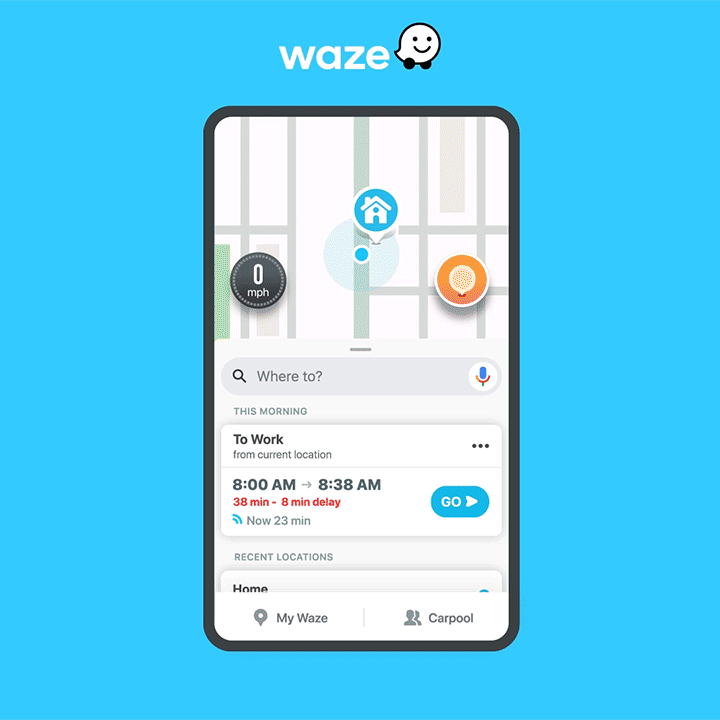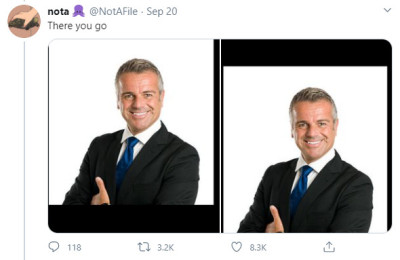Technology
Waze just got a bunch of new features that you have to check out
- Waze announced on Tuesday a variety of new features that should further improve the commuting experience of drivers and people using the app to carpool.
- Waze can make trip suggestions based on your habits, and let you access recent locations with ease. The app will issue notifications if it detects worsening traffic conditions for an upcoming drive, and will support lane guidance instructions.
- The integration with Google Assistant supports more languages, Amazon Music integration is available to Waze users, and Waze Carpool can pair drivers with riders even faster.
Apple might have dominated the news on Tuesday with the reveal of new Apple Watch and iPad models. But it just so happens that Waze hosted its own press event on Tuesday as well to introduce new features meant to improve your commute even further, whether you’re in the driver seat or looking for carpooling options.
The new Waze Trip Suggestion feature will now show you personalized recommendations that are based on previous trips or locations that you may have driven to. This can come in handy if you’re commuting to work every day, as Waze will now tell you what to expect for your next trip. Trip Suggestions will indicate the trip duration and expected traffic, allowing you to prepare better for unforeseen problems.

The new Recent Locations feature will show recent destinations, allowing you to start your navigation towards the same address quickly, be it your home, work, school, or some other destination that you visit often.
Even better than that is the new Traffic Notifications feature that will issue alerts about the traffic towards your favorite and recent destinations. Once Waze detects traffic issues that may alter your travel time, it will send notifications urging you to take action.
Waze will also get a few useful features for the driving experience. The app now integrates Google Assistant, complete with support for French, Spanish, and Portuguese. You’ll be able to issue commands to Waze rather than touching the screen of the handset. A partnership with Amazon will let you play Amazon Music while using Waze navigation, as long as you also have access to Amazon’s music streaming app.
Following ETA improvements for Google Maps, Google has now improved the feature on Waze as well. Waze says it has adapted to the new driving conditions of the novel coronavirus pandemic to update its ETA calculations in areas where there are fewer drivers than ever.
The lane guidance feature that leaked a few months ago has also started rolling out to users. If you’re using Waze for carpooling purposes, you can now set the price for the next ride if the recommendation doesn’t fit your needs. Features like Instant Book and Auto Approve should speed up the whole approval experience. With Real-Time Rides on, Waze will tell drivers at the start of the drive about other riders on their route looking for a car and let drivers offer them a ride.
Not all the new features will be available immediately, or in all markets. Trip Suggestions, Recent Locations, Traffic Notifications will be available next month. The new carpool price-setting feature is available in Brazil, Israel, and Mexico today. Instant Book and Auto Approve are also available today in the same markets and rolling out to US users on Tuesday. Real-Time Rides will roll out this month in Israel, followed by other Waze Carpool markets. ETA improvements are also available today, as is Google Assistant in English. Support for the other languages and Amazon Music integration will be rolling out to Waze apps in the coming months.
Technology
California looks to eliminate gas guzzlers—but legal hurdles abound
California governor Gavin Newsom made a bold attempt today to eliminate sales of new gas-guzzling cars and trucks, marking a critical step in the state’s quest to become carbon neutral by 2045. But the effort to clean up the state’s largest source of climate emissions is almost certain to face serious legal challenges, particularly if President Donald Trump is reelected in November.
Newsom issued an executive order that directs state agencies, including the California Air Resources Board, to develop regulations with the “goal” of ensuring that all new passenger cars and trucks sold in the state are zero-emissions vehicles by 2035. That pretty much limits future sales to electric vehicles (EVs) powered by batteries or hydrogen fuel cells. Most new medium- and heavy-duty vehicles would need to be emissions free by 2045.
These shifts could be accomplished through restrictions on internal-combustion-engine vehicles, or through subsidies or other policy instruments that tighten or become more generous, over time. If those rules are enacted, it would be one of the most aggressive state climate policies on the books, with major implications for the auto industry.
The roughly 2 million new vehicles sold in the state each year would eventually all be EVs, providing a huge boost to the still nascent vehicle category.
“California policy, especially automotive policy, has cascading effects across the US and even internationally, just because of the scale of our market,” says Alissa Kendall, a professor of civil and environmental engineering at the University of California, Davis.
Indeed, the order would mean more auto companies would produce more EV lines, scaling up manufacturing and driving down costs. The growing market would, in turn, create greater incentives to build out the charging or hydrogen-fueling infrastructure necessary to support a broader transition to cleaner vehicles.
The move also could make a big dent in transportation emissions. Passenger and heavy-duty vehicles together account for more than 35% of the state’s climate pollution, which has proved an especially tricky share to reduce in a sprawling state of car-loving residents (indeed, California’s vehicle emissions have been ticking up).
But Newsom’s executive order only goes so far. It doesn’t address planes, trains, or ships, and it could take another couple of decades for residents to stop driving all the gas-powered vehicles already on the road.
Whether the rules go into effect at all, and to what degree, will depend on many variables, including what legal grounds the Air Resources Board uses to justify the policies, says Danny Cullenward, a lecturer at Stanford’s law school who focuses on environmental policy.
One likely route is for the board to base the new regulations on tailpipe emissions standards, which California has used in the past to force automakers to produce more fuel-efficient vehicles, nudging national standards forward. But that approach may require a new waiver from the Environmental Protection Agency allowing the state to exceed the federal government’s vehicle emissions rules under the Clean Air Act, the source of an already heated battle between the state and the Trump administration.
Last year, Trump announced he would revoke the earlier waiver that allowed California to set tighter standards, prompting the state and New York to sue. So whether California can pursue this route could depend on how courts view the issue and who is in the White House come late January.
It’s very likely that the automotive industry will challenge the rules no matter how the state goes about drafting them. And the outcome of those cases could depend on which court it lands in—and perhaps, eventually, who is sitting on the Supreme Court.
But whatever legal hurdles they may face, California and other states need to rapidly cut auto emissions to have any hope of combating the rising threat of climate change, says Dave Weiskopf, a senior policy advisor with NextGen Policy in Sacramento.
“This is what science requires, and it’s the next logical step for state policy,” he says.
Update: This story was updated to clarify that the order wouldn’t necessarily achieve its goals through a ban on internal-combustion-engine vehicles.
Technology
Community Testing Suggests Bias in Twitter’s Cropping Algorithm
With social media and online services are now huge parts of daily life to the point that our entire world is being shaped by algorithms. Arcane in their workings, they are responsible for the content we see and the adverts we’re shown. Just as importantly, they decide what is hidden from view as well.
Important: Much of this post discusses the performance of a live website algorithm. Some of the links in this post may not perform as reported if viewed at a later date.
Recently, [Colin Madland] posted some screenshots of a Zoom meeting to Twitter, pointing out how Zoom’s background detection algorithm had improperly erased the head of a colleague with darker skin. In doing so, [Colin] noticed a strange effect — although the screenshot he submitted shows both of their faces, Twitter would always crop the image to show just his light-skinned face, no matter the image orientation. The Twitter community raced to explore the problem, and the fallout was swift.
Intentions != Results

Twitter users began to iterate on the problem, testing over and over again with different images. Stock photo models were used, as well as newsreaders, and images of Lenny and Carl from the Simpsons, In the majority of cases, Twitter’s algorithm cropped images to focus on the lighter-skinned face in a photo. In perhaps the most ridiculous example, the algorithm cropped to a black comedian pretending to be white over a normal image of the same comedian.

Many experiments were undertaken, controlling for factors such as differing backgrounds, clothing, or image sharpness. Regardless, the effect persisted, leading Twitter to speak officially on the issue. A spokesperson for the company stated “Our team did test for bias before shipping the model and did not find evidence of racial or gender bias in our testing. But it’s clear from these examples that we’ve got more analysis to do. We’ll continue to share what we learn, what actions we take, and will open source our analysis so others can review and replicate.”
There’s little evidence to suggest that such a bias was purposely coded into the cropping algorithm; certainly, Twitter doesn’t publically mention any such intent in their blog post on the technology back in 2018. Regardless of this fact, the problem does exist, with negative consequences for those impacted. While a simple image crop may not sound like much, it has the effect of reducing the visibility of affected people and excluding them from online spaces. The problem has been highlighted before, too. In this set of images of a group of AI commentators from January of 2019, the Twitter image crop focused on men’s faces, and women’s chests. The dual standard is particularly damaging in professional contexts, where women and people of color may find themselves seemingly objectified, or cut out entirely, thanks to the machinations of a mysterious algorithm.

Former employees, like [Ferenc Huszár], have also spoken on the issue — particularly about the testing process the product went through prior to launch. It suggests that testing was done to explore this issue, with regards to bias on race and gender. Similarly, [Zehan Wang], currently an engineering lead for Twitter, has stated that these issues were investigated as far back as 2017 without any major bias found.
It’s a difficult problem to parse, as the algorithm is, for all intents and purposes, a black box. Twitter users are obviously unable to observe the source code that governs the algorithm’s behaviour, and thus testing on the live site is the only viable way for anyone outside of the company to research the issue. Much of this has been done ad-hoc, with selection bias likely playing a role. Those looking for a problem will be sure to find one, and more likely to ignore evidence that counters this assumption.
Efforts are being made to investigate the issue more scientifically, using many studio-shot sample images to attempt to find a bias. However, even these efforts have come under criticism - namely, that using an source image set designed for machine learning and shot in perfect studio lighting against a white background is not realistically representative of real images that users post to Twitter.

Twitter’s algorithm isn’t the first technology to be accused of racial bias; from soap dispensers to healthcare, these problems have been seen before. Fundamentally though, if Twitter is to solve the problem to anyone’s satisfaction, more work is needed. A much wider battery of tests, featuring a broad sampling of real-world images, needs to be undertaken, and the methodology and results shared with the public. Anything less than this, and it’s unlikely that Twitter will be able to convince the wider userbase that its software isn’t failing minorities. Given that there are gains to be made in understanding machine learning systems, we expect research will continue at a rapid pace to solve the issue.
Technology
Anti-Piracy Group Seeks Owners Of YTS, Pirate Bay And Others
The Alliance for Creativity and Entertainment (ACE) is attempting to uncover the owners of pirate sites like YTS, Pirate Bay, Tamilrockers, and several others.
For that purpose, ACE previously filed a DMCA subpoena that requires Cloudflare to unveil operators of several pirate sites. According to the latest report from Torrent Freak, a total of 46 high profile pirate websites have been named by the anti-piracy coalition.
ACE is an anti-piracy organization that crackdowns on the operators of pirate websites. Some of its members include Amazon, Netflix, Disney, and Paramount Pictures. The latest targets of this crackdown are pirate sites using Cloudflare. For the uninitiated, Cloudflare is a content delivery network (CDN) service provider used by millions of websites globally.
In the first half of 2020, Cloudflare received 31 such requests, concerning 83 accounts, most of which were related to adult sites.
The current subpoena targets 46 pirate websites, including some big fish like Pirate Bay, YTS, 1337x, 123Movies, and more. Once in action, it’ll force Cloudflare to reveal the IP addresses, emails, names, physical addresses, phone numbers, and payment methods of the people operating these websites.
Here is the list of domains that ACE wants to gather information on —
- yts.mx
- pelisplus.me
- 1337x.to F
- seasonvar.ru
- cuevana3.io
- kinogo.by
- thepiratebay.org
- lordfilm.cx
- swatchseries.to
- eztv.io
- 123movies.la
- megadede.com
- sorozatbarat.online
- cinecalidad.is
- limetorrents.info
- cinecalidad.to
- kimcartoon.to F
- tamilrockers.ws
- cima4u.io
- fullhdfilmizlesene.co
- yggtorrent.si
- time2watch.io
- online-filmek.me
- lordfilms-s.pw
- extremedown.video
- streamkiste.tv
- dontorrent.org
- kinozal.tv
- fanserial.net
- 5movies.to
- altadefinizione.group
- cpasmieux.org
- primewire.li
- primewire.ag
- primewire.vc
- series9.to
- europixhd.io
- oxtorrent.pw
- pirateproxy.voto
- rarbgmirror.org
- rlsbb.ru
- gnula.se
- rarbgproxied.org
- seriespapaya.nu
- tirexo.com
- cb01.events
- kinox.to
- filmstoon.pro
- descargasdd.net
Earlier in August, it was reported that torrent giant YTS had revealed user data with a law firm. This led to the users receiving letters from the law firm, asking them to pay around $1,000 for using the pirate site or be named in a lawsuit for piracy.
Recently, ACE has set out on a crusade to banish pirate websites. While there has been no significant action from the group in the past few years, 2020 is seeing increasing activity in reporting and controlling piracy.
The post Anti-Piracy Group Seeks Owners Of YTS, Pirate Bay And Others appeared first on Fossbytes.
-
 Business2 months ago
Business2 months agoBernice King, Ava DuVernay reflect on the legacy of John Lewis
-
World News2 months ago
Heavy rain threatens flood-weary Japan, Korean Peninsula
-
 Technology2 months ago
Technology2 months agoEverything New On Netflix This Weekend: July 25, 2020
-
Finance4 months ago
Will Equal Weighted Index Funds Outperform Their Benchmark Indexes?
-
Marketing Strategies9 months ago
Top 20 Workers’ Compensation Law Blogs & Websites To Follow in 2020
-
 World News8 months ago
World News8 months agoThe West Blames the Wuhan Coronavirus on China’s Love of Eating Wild Animals. The Truth Is More Complex
-
Economy11 months ago
Newsletter: Jobs, Consumers and Wages
-
 Finance9 months ago
Finance9 months ago$95 Grocery Budget + Weekly Menu Plan for 8

